HISTORY OF THE ECONOMIC MELTDOWN (TIMELINE) 2007-2009 FINANCIAL CRISIS
History of the 2008 Financial Crisis "The Meltdown"
During the course of the economic meltdown, there was a timeline that a gentleman posted where he routinely updated the course of events with dates and key occurrences. I often submitted information and anonymously maintained contact with the site "owner". Let's take a look back at 10 years ago this Spring - join me in the time machine as we visit the History of the Meltdown. (I post this out of respect and preservation should anything ever happen to his original site, this must be preserved!)
History of the Meltdown…
March 28, 2007
“The problems in the subprime market seems likely to be contained.”— Ben Bernanke, Federal Reserve chairman, March 28, 2007
This unfortunate collection of words by Bernanke has been quoted over and over again as proof the Fed chief did not grasp the gravity of the subprime debacle.
He made this comment as part of testimony he gave to the Joint Economic Committee of Congress, and it came back to haunt him when the financial sector began to collapse.
July 31, 2007 Two Bear Stearns funds that invested in mortgage securities file bankruptcy.
Aug. 9, 2007 French bank BNP Paribas freezes three funds with U.S. mortgage exposure, helping to spark a worldwide credit squeeze.
Oct. 11, 2007 The Dow hit its all-time high of 14,279 during the afternoon. It’s all downhill from here.
Oct, 30, 2007 Amid mounting losses, Merrill Lynch CEO Stan O’Neal resigns.
Nov. 4, 2007 Citigroup CEO Charles Prince steps down.
Dec, 2007 US recession officially begins (but won’t be announced until Dec. 1, 2008). [link]
2008
Jan. 11, 2008 Countrywide Financial insolvent. Bank of America agrees to buy them out, saving them from bankruptcy.
Feb. 1, 2008 Exxon Mobil posts the largest annual profit by a U.S. company in history of $40.6 billion — a record that will not be broken for decades.
Feb. 12, 2008 General Motors announces losses of $38.7 billion last year, the largest annual loss in automotive history, and offers buyouts to 74,000 hourly workers.
Mar. 12, 2008 “We don’t see any pressure on our liquidity, let alone a liquidity crisis.”
Alan Schwartz, former CEO of Bear Stearns, March 12, 2008.
Schwartz was fending off speculation that the investment banking giant was in a cash crunch when he made this statement, trying to reassure investors that Bear Stearns was doing OK.
March 16, 2008 Bear Stearns dies. JPMorgan Chase snatches them up at firesale price. The Gov’t coughs up $30 billion to sweeten the deal.
Gold & silver are hitting new highs every other day.
March 16, 2008 “We have more capital than we need, so we can say to the market that we don’t need more injections. We can confirm that we have tackled the problem.” John Thain, former CEO, Merrill Lynch, March 16, 2008
Merrill Lynch would become insolvent Sept. 15.
July 11, 2008 IndyMac Bank dies, becomes the third-largest bank failure in U.S. history. Check out this video of angry customers from Encino, CA on TV station KTLA [link]
July 11, 2008 Oil prices reach all-time high of $147 a barrel. Gas at the pump over $5/gallon.
July 15, 2008 “I don’t think the government ought to be involved in bailing out companies.”
George Bush, President of the United States
Bush made this statement in a press conference where he reiterated he felt the economy was basically sound. By the end of the year the gov’t would be involved in the bailouts of AIG, Fannie Mae, Freddie Mac, CitiGroup, GM, Chrysler, Ford, every one of the 10 largest banks (through TARP and the Fed loan window).
July 16, 2008 “I think the system basically is sound, I truly do,” Bush said. “And I understand there’s a lot of nervousness. . . . But the economy is growing, productivity is high, trade is up, people are working. It’s not as good as we’d like, but . . . to the extent that we find weakness, we’ll move.” [link]George Bush, President of the United States
With three more financial outlets collapsing under the economical meltdown last week, queues of angry people outside banks with no access to their money, inflation at its highest rate in 27 years and scores of economists predicting a recession may tip into a full blown depression, president Bush reacted by declaring that the economy is still fundamentally sound.
July 24, 2008 Ford Motor Co. posts worst quarterly performance in its history, losing $8.67 billion, and plans to quickly change focus from trucks to small cars.
Sept. 5, 2008 Silver State Bank is closed in the 11th bank failure of the year.
Sept. 7, 2008 Fannie Mae and Freddie Mac on the ropes. The government seizes them at a cost of $200 billion.
Sept. 11, 2008 Sudden $550 billion drawdown in money market deposits. (This unexpected event was revealed to Congress in secret on Sept. 15, 2008 and not made public until Feb. 6, 2009. This may have been the “trigger event” for the US banking crisis. [What You Weren’t Told on 9/11/2008].)
Sept. 15, 2008 158 year-old Lehman Brothers files bankruptcy. At $630 billion it’s the largest bankruptcy in US history. This sparks a chain reaction that sends credit markets into disarray.
Merrill Lynch in trouble, Bank of America agrees to buy them out for $50 billion.
Sept. 16, 2008 World’s largest insurer AIG insolvent. Government takes control of them for $85 billion. AIG is replaced by Kraft Foods as a component of the DJIA index.
The nation’s first money-market fund collapses when it “breaks the buck” and is frozen. Two days later Paulson & Bernanke extend federal insurance to some $3.4 trillion in money-market funds.
Sept. 17, 2008 Stock market down 9% in two days.
Gold posts its biggest 24-hr gain (percentage and actual $ amount) in history.
Russian stock market is closed for two days after it dives 25%.
Sept. 18, 2008 Sec Treasury Paulson proposes the biggest financial bailout in US history. It grows from an estimated $300 billion to $700 billion in three days.
Sept. 19, 2008 SEC temporarily bans short sales of 800 stocks from today through October 2.
Sec Treasury Paulson asks for unprecedented and unrestrictedauthority to use taxpayer money to bailout any financial entity.
Sept. 21, 2008 Eager to be eligible for the Fed’s bank-only billion dollar handouts, Goldman Sachs and Morgan Stanley suddenly transform themselves into deposit-taking banks.
Sept. 25, 2008 Washington Mutual, the US’s largest S&L, becomes the largest bank failure in history. It is seized by the Feds and sold off to JPMorgan Chase.
Sept. 27, 2008 “Legislative” Martial Law is declared by the Speaker of the House in an effort to ram through the $700 billion Bailout Bill. This attempt fails.
Sept. 29, 2008 Wachovia, the nation’s 4th largest bank, in trouble. The FDIC brokers its sale to CitiGroup (eventually Wells Fargo beats out CitiGroup).
The DJIA suffers its biggest point-drop in history; the VIX “Fear Index” sets a new all-time high at 48.40.
Oct. 3, 2008 House passes $700 billion Bankster Bailout Bill. President immediately signs it into law. The Executive Branch now has unrestricted control over who gets what for bailouts.
Oct. 6, 2008 The VIX “Fear Index” sets another new all-time high at 58.24. Dow drops to 9,955, first close below 10,000 since 2004.
Oct. 7, 2008 Russia, Brazil and Peru suspend trading when their stock markets fall nearly 20% at open.
Prime Ministrer of Iceland warns of impeding bankruptcy of his country.
Oct. 8, 2008 The Federal Reserve, European Central Bank and four other central banks lowered world-wide interest rates in an unprecedented coordinated effort to ease the economic effects of the worst financial crisis since the Great Depression.
Oct. 9, 2008 Iceland suspends trading on its stock market for the rest of the week. Its three largest banks have failed.
European Central Bank announces “unlimited” amount of cash available to banks.
Oct. 10, 2008 The Dow had its worst week in both point and percentage terms and is down 40.3% since reaching a record high close of 14,164.53 on Oct. 9, 2007. In the last 8 trading days alone, the blue chip index has lost a staggering 22.1% of its value. The past week’s (October 6 – 10) 18% decline “and Friday’s 1018.77 point swing from low to high were the biggest since the Dow was created in 1896.”Britain was just three hours away from going bust today after a secret run on the banks. This wasn’t revealed until Jan 24, 2009 by one of British Prime Minister Gordon Brown’s ministers. [link]
Oct. 11, 2008 Top 9 US banks nationalized. Emergency meeting called by Sec Treasury Paulsen. He tells the CEOs of the nation’s top 9 banks, from Bank of America to Wells Fargo, that the financial system is in trouble and he is nationalizing them. Each CEO receives a single sheet of paper saying they agree to receive a total of $125 billion in exchange for shares. [NY Times, Oct 14, 2008]
Oct. 13, 2008 Dow chalks up its biggest-ever one-day point gain to close over 9,000 after last week’s devastating losses.
US Fed authorizes unlimited dollars for distribution by European Central Banks. The flood of new dollars is estimated at $2.3 trillion worldwide.
Oct 15, 2008 Monday’s huge Dow gain is countered by today’s huge loss of 733 pts.
Oct 16, 2008 Oil prices fall below $70 a barrel, less than half the July peak.
Nov 6, 2008 U.S. Stocks Tumble in Market’s Worst Two-Day Slump Since 1987 (Bloomberg.com). S&P 500 down 10%.
Nov 7, 2008 Unemployment jumps to 14-year high of 6.5%.
Nov 19, 2008 Dow dives under 8,000 — lowest close since March 2003.
Nov 23, 2008 Citigroup, once the nation’s largest and mightiest financial institution, has been brought to its knees by more than $65 billion in losses. Citigroup’s stock has plummeted to its lowest price in more than a decade, closing Friday at $3.77. At that price the company is worth just $20.5 billion, down from $244 billion two years ago. Waves of layoffs have accompanied that slide, with about 75,000 jobs already gone or set to disappear from a work force that numbered about 375,000 a year ago.
Nov 26, 2008
With the gov’t bailout of Citicorp, US bailouts now total almost 35% of GDP. First it was the banks. Then Fannie Mae and Freddie Mac followed by AIG, Citigroup and now possibly auto companies, the home builders and the legacy airlines. Increasingly, the American government is becoming Corporate America’s largest investor. The U.S. government now owns or operates 35% of the entire economy’s production or gross domestic product (GDP).
Dec 1, 2008 Announcement: US recession officially started in Dec 2007.The National Bureau of Economic Research declared, “The committee determined that the decline in economic activity in 2008 met the standard for a recession.” The 1.2 million drop in payroll employment so far this year was the biggest factor in determining that start of the contraction. [link]
Dec 17, 2008 A panicked Ben Bernanke cuts the Fed Funds Rate to zero, it’s lowest in history.
From Bloomberg: “The Federal Reserve opened a new era in U.S. monetary history, cutting interest rates to as low as zero and pledging to buy unlimited quantities of securities, after conventional policies failed to arrest what may be the worst recession since World War II.”
Dec 23, 2008 Median home sales price fell 13.2 percent — the largest amount on record — to $181,300, from $208,000 a year ago. Biggest drop since the Great Depession. [link]
Dec 30, 2008 Consumer confidence hits all-time low in Dec.
The Conference Board’s Consumer Confidence Index fell to 38 in December from a revised 44.7 in November. [link]
2009
Jan 2, 2009 US manufacturing shrinks as orders hit 60-year low. [link] Things haven’t been this bad since 1948.Billionaire Warren Buffett’s Berkshire Hathaway slumped 32 percent last year, the worst performance in more than three decades. [link]
Jan 8, 2009 Bank of England cuts interest rate to lowest since 1694. Yes, that’s the lowest rate in 300+ years, since England’s central bank was founded. [link]
Jan 9, 2009 US: highest job losses for year since WWII.Battered by the worst housing market collapse in the country’s history and by an ever-deeper credit crunch, the US economy shed 2.6m jobs in 2008, the largest decline since a 2.75m drop in 1945, when the dole queues were briefly swelled by servicemen being demobilised. [link]
Jan 16, 2009 RIP Circuit CityAfter filing for bankruptcy protection in Nov 2008, Circuit City throws in the towel today and announces it will liquidate all its remaining inventory and close its stores. 35,000 to lose jobs. [link]
Jan 19, 2009 Royal Bank of Scotland announced the biggest loss in British corporate history today. The news triggered fears the bank would be nationalised and caused a bloodbath in shares across the sector, overshadowing the Government’s latest financial bailout. [link]
Jan 21, 2009 Iceland sinks further into economic oblivion as violent protesters are gassed by police (1st time in 60 years). [link]
Jan 22, 2009 Toyota overtook General Motors in global vehicle sales for the first time, bringing to an end GM’s 77-year run as the world’s largest automaker. [link]
Jan 26, 2009 Bloody Monday: 71,400 job layoffs announced in US. Seven companies announce massive job cuts in a scary start to the week. [link]
Jan 27, 2009 US consumer confidence hits all-time low.
The Conference Board’s index of consumer confidence fell to 37.7, the lowest rating since records began in 1967. [link]
Jan 29, 2009 US unemployment checks set record.
The Labor Department reported that the number of Americans continuing to claim unemployment insurance for the week ending Jan. 17 was a seasonally adjusted 4.78 million, the highest on records dating back to 1967. [link]
Jan 30, 2009 The FDIC closes 3 more banks today, bringing the total to 31since the start of the credit crisis. The failure of Utah’s MagnetBank was different: it became the first time in five yearsthe FDIC was forced to directly refund depositors after being unable to find another institution willing to take over its operations. [link]
Feb 5, 2009 Credit Suisse posts largest annual loss ever. [link]
Feb 13, 2009 Four U.S. Banks Seized, Bringing Total for Year to 13. Banks in Florida, Illinois, Nebraska and Oregon were shut by state regulators, boosting the toll of failed institutions to 13, as a worsening economy and slumping housing market pushes home foreclosures to records. [link]
Feb 18, 2009 New home construction drops to record low. The Commerce Department reported that construction of new homes dropped 16.8 percent last month, and was the slowest pace on records dating back a half-century. [link]
Feb 20, 2009 DJIA and S&P 500 give back all gains for past 11 years(1997). This, on top of the S&P 500’s worst start to a year EVER, down 17% so far in 2009. [link]
Feb 23, 2009 A total of 288 US companies cut or suspended payouts last quarter, the most since Standard & Poor’s records began 54 years ago, when Dwight D. Eisenhower was president. This is the fastest reduction in U.S. dividends since 1955. [link]
Feb 24, 2009 Confidence among U.S. consumers plunged to a record low in February. The Conference Board’s index declined more than forecast to 25 this month, the lowest level since data began in 1967, from a January reading of 37.4.
Bloomberg also reports, “Home prices in 20 U.S. cities declined 18.5 % in December from a year earlier, the fastest drop on record, as foreclosures climbed and sales sank.” [link]
Feb 27, 2009 General Electric announces it will slash its quarterly dividend 68% beginning in the 3rd quarter. As recently as January, GE CEO Jeffrey Immelt, told CNBC that he had no plans to cut the dividend, which the company has paid for over 100 years. The last time GE decreased its dividend was 1938. [link]
Mar 2, 2009 DJIA March 2, 2009DJIA plunges below 7,000 as investors grow increasingly pessimistic about the health of banks, and in turn the economy, around the world. The Dow hadn’t traded below 7,000 since Oct. 28, 1997, and last closed below that mark on May 2 of that year. [link] [link]AIG posted the largest quarterly loss in history, $61.7 billion. AIG was once the world’s largest insurer. It received a $150 billion bailout in 2008, and is about to receive another $30 billion from the gov’t. [link]
Mar 5, 2009 With today’s 4% drop in the DOW, the current Dow correction already ranks as the second worst on record. Only the correction that began in 1929 was worse. [see the chart]
Mar 6, 2009 U.S. jobless rate soars to 8.1%. 651,000 lose their jobs in February; unemployment at highest level since 1983. 4.4 million jobs have been lost since the start of the recession in Dec. 2007. Half of those job losses have happened in the last 4 months. [link]
The site was abandoned at about this time with visitors using the comment section to further update events as they unfolded. Bank failures dominated the news as well as continued layoffs and economic troubles.
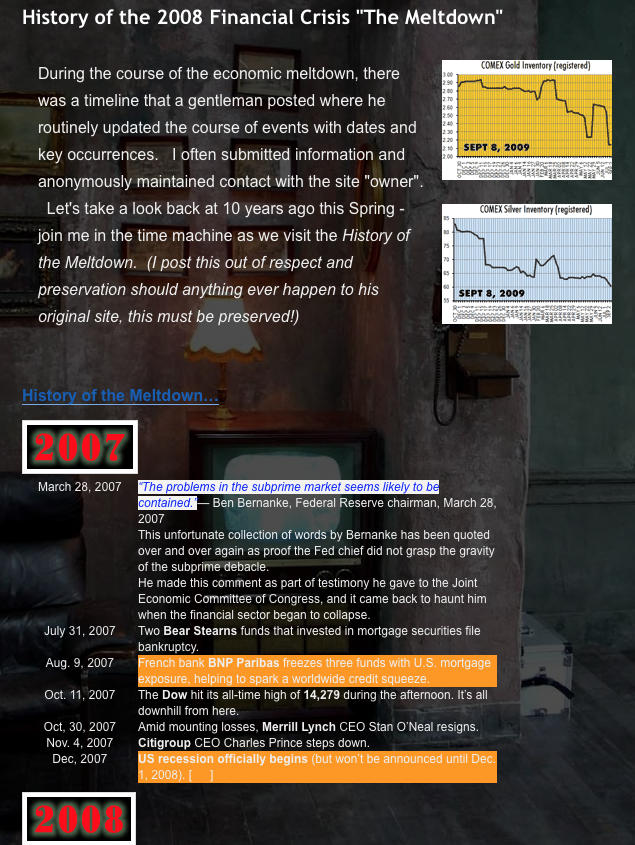
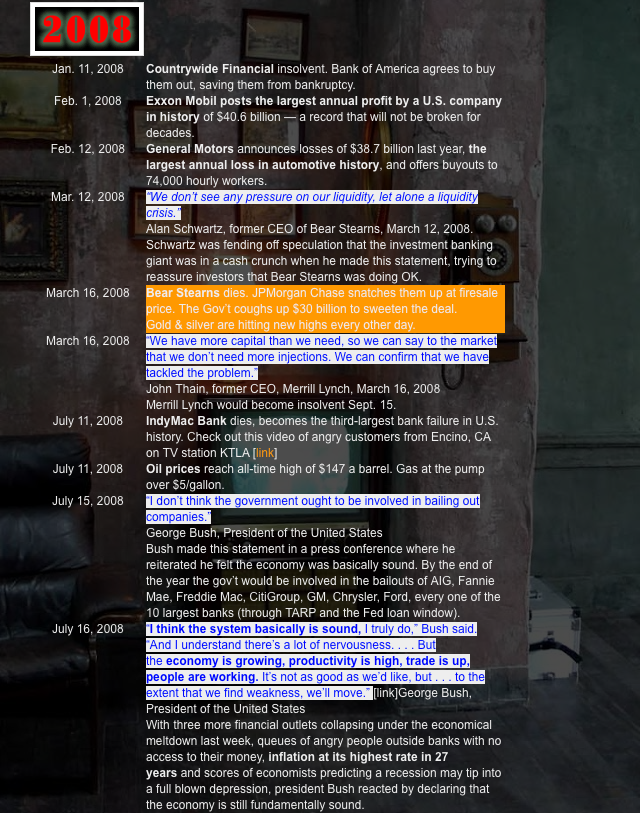
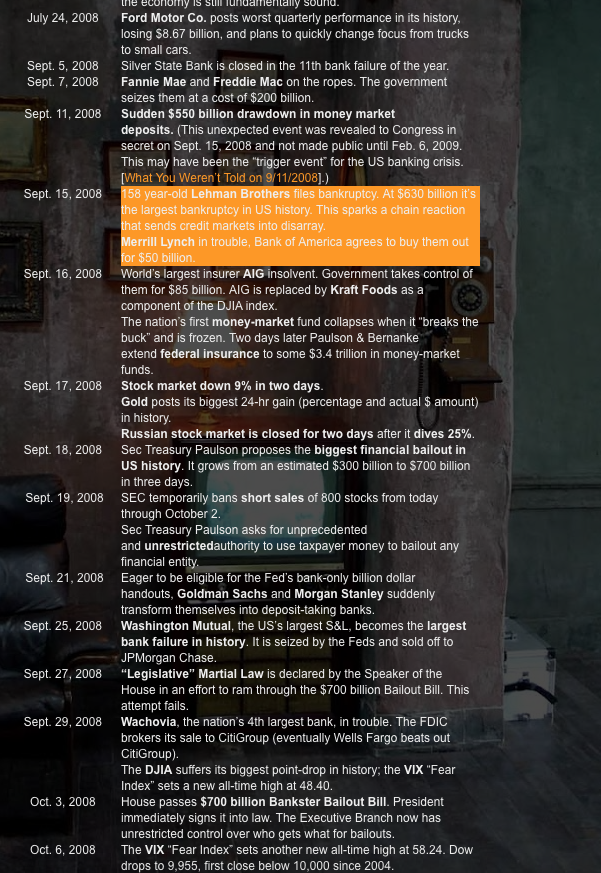
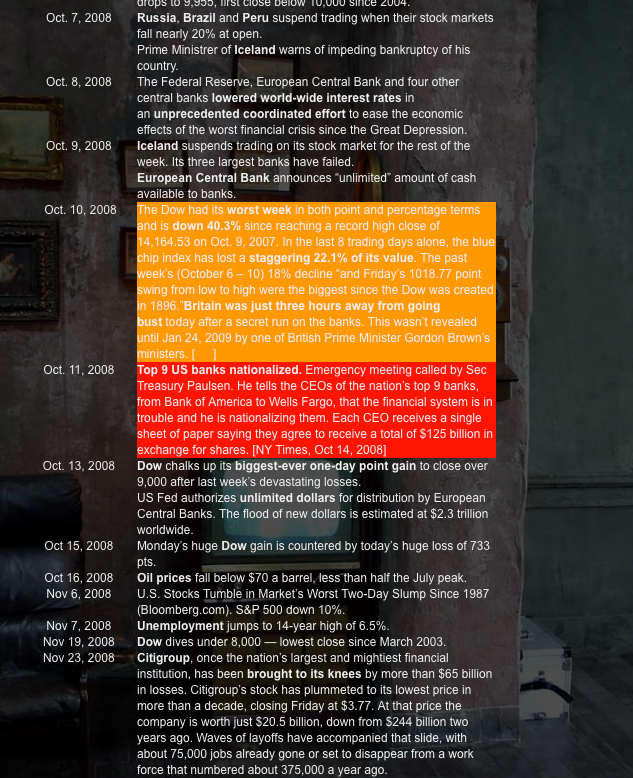
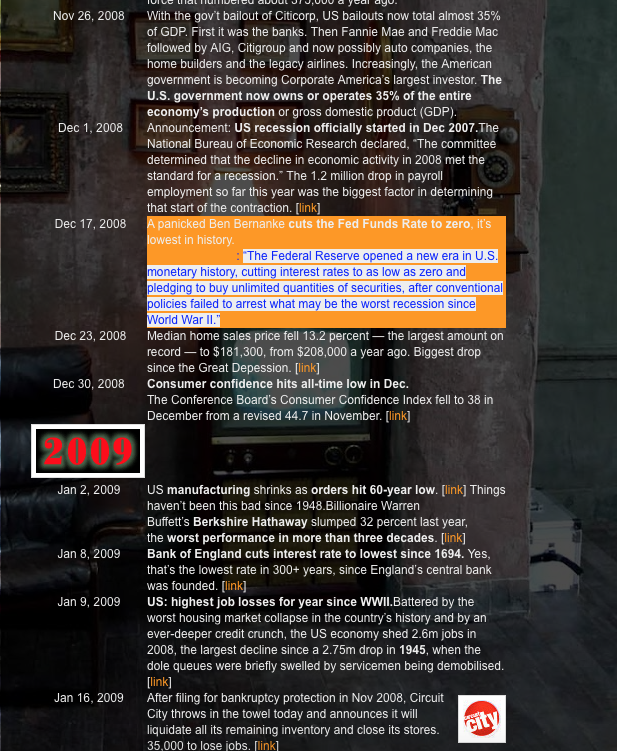
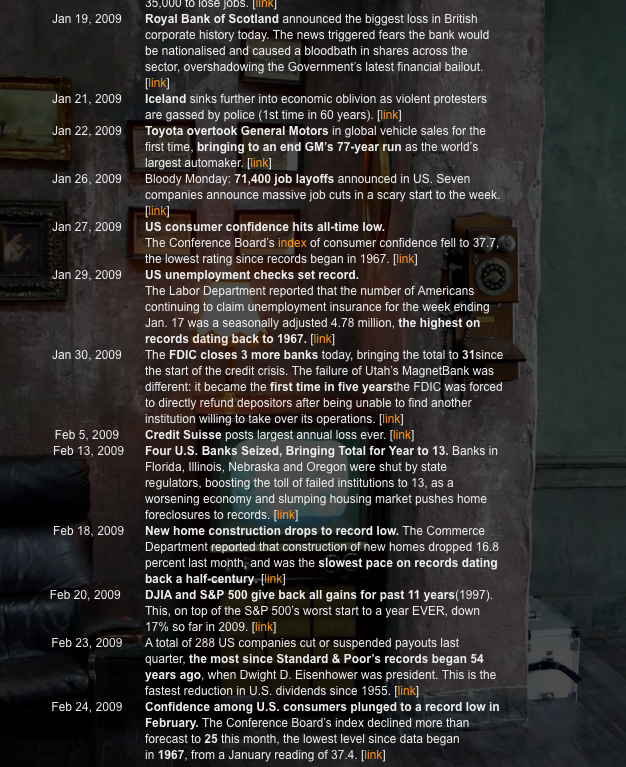
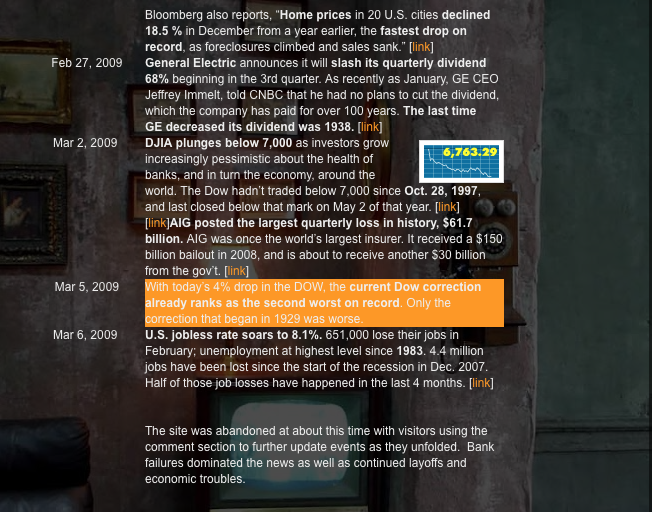
PLEASE LIKE, COMMENT AND RE-STEEM!
Wow! Awesome read
Thank you!! I hope more can see it. The anniversary months are here TEN YEARS AGO THE RECESSION BEGAN!
Kinda hoping for something similar...at least for Gold and Silver!